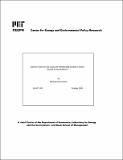| dc.contributor.author | Greenstone, Michael | en_US |
| dc.contributor.other | Massachusetts Institute of Technology. Center for Energy and Environmental Policy Research. | en_US |
| dc.date.accessioned | 2009-04-03T17:06:02Z | |
| dc.date.available | 2009-04-03T17:06:02Z | |
| dc.date.issued | 2003 | en_US |
| dc.identifier | 2004-007 | en_US |
| dc.identifier.uri | http://hdl.handle.net/1721.1/45016 | |
| dc.description.abstract | Over the last three decades, ambient concentrations of sulfur dioxide (SO2) air pollution have declined by approximately 80%. This paper tests whether the 1970 Clean Air Act and its subsequent amendments caused this decline. The centerpiece of this legislation is the annual assignment of all counties to SO2 nonattainment or attainment categories. Polluters face stricter regulations in nonattainment counties. There are two primary findings. First, regulators pay little attention to the statutory selection rule in their assignment of the SO2 nonattainment designations. Second, SO2 nonattainment status is associated with modest reductions in SO2 air pollution, but a null hypothesis of zero effect generally cannot be rejected. This finding holds whether the estimated effect is obtained with linear adjustment or propensity score matching. Overall, the evidence suggests that the nonattainment designation played a minor role in the dramatic reduction of SO2 concentrations over the last 30 years. | en_US |
| dc.format.extent | 26, [14] p | en_US |
| dc.publisher | MIT Center for Energy and Environmental Policy Research | en_US |
| dc.relation.ispartofseries | MIT-CEEPR (Series) ; 04-007WP. | en_US |
| dc.title | Did the Clean Air Act cause the remarkable decline in sulfur dioxide concentrations? | en_US |
| dc.type | Working Paper | en_US |
| dc.identifier.oclc | 58676395 | en_US |
